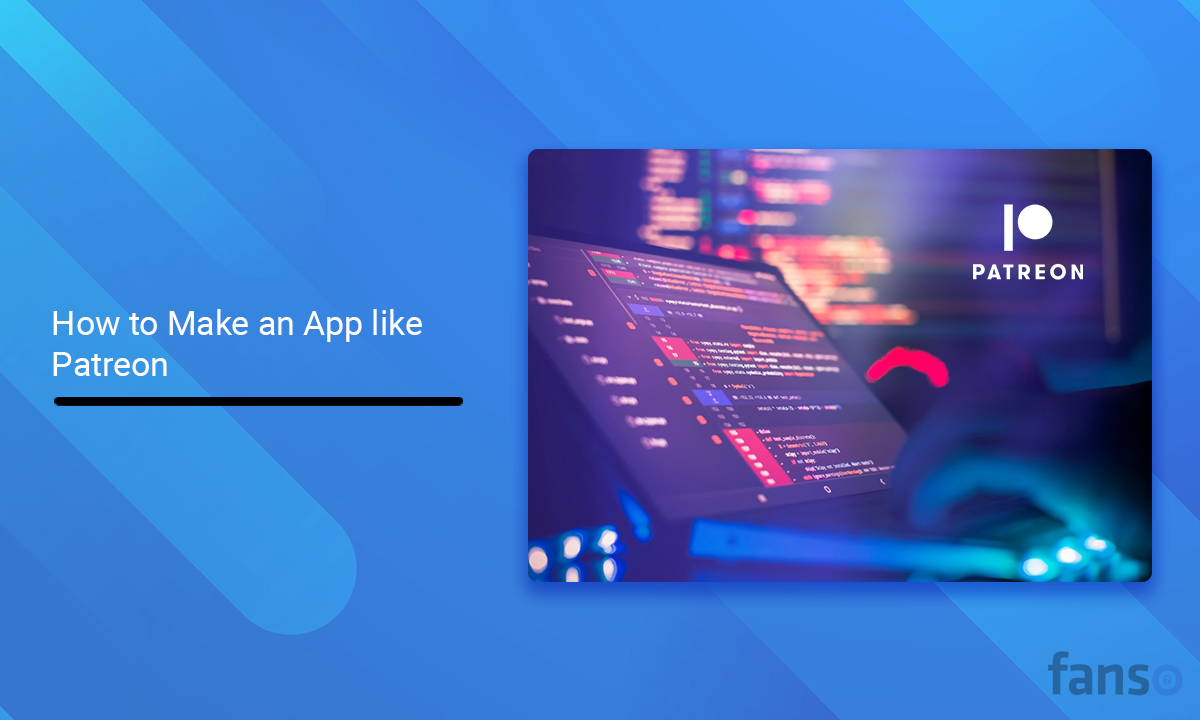Rewind the creator economy to a decade ago — a phenomenal platform with the sole intention of getting creators paid emanated in the creator landscape. Patreon’s business model helped creators to monetize their greatest creations and offer an engaging community experience!
Fast-forward 10 years ahead — Patreon is a $4 billion company revolutionizing the creator economy! Yes, Patreon’s staggering growth can be traced back to a problem: artists couldn’t earn enough for their work! Have you stumbled across a similar puzzle and wondered how to make an app like Patreon?
Then, you are in the right place! In this blog we walk you through a detailed process to build an app like Patreon: from finding your niche to promoting your product and everything in between! So, are you ready to don your entrepreneurial hats?
Table of Contents
Why Develop an App like Patreon?
Listed below are some interesting insights of Patreon:
- Overall, Patreon has issued payouts of $3.5 billion to creators. (Patreon)
- Patreon had around 101.1 million website visits and the annual revenue is around $50-$75 million as of May 2024. It takes a 8% and 12% sales cut from creator earnings. (SimilarWeb)
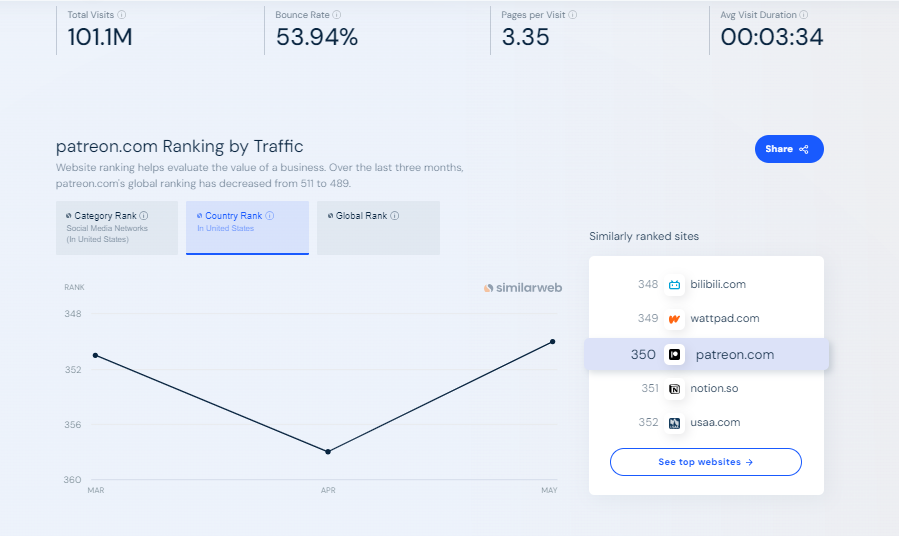
- Patreon has around 252,015 creators with at least one patron as of February 2024. It has increased about 17.74% since February 2023. (Graphtreon)
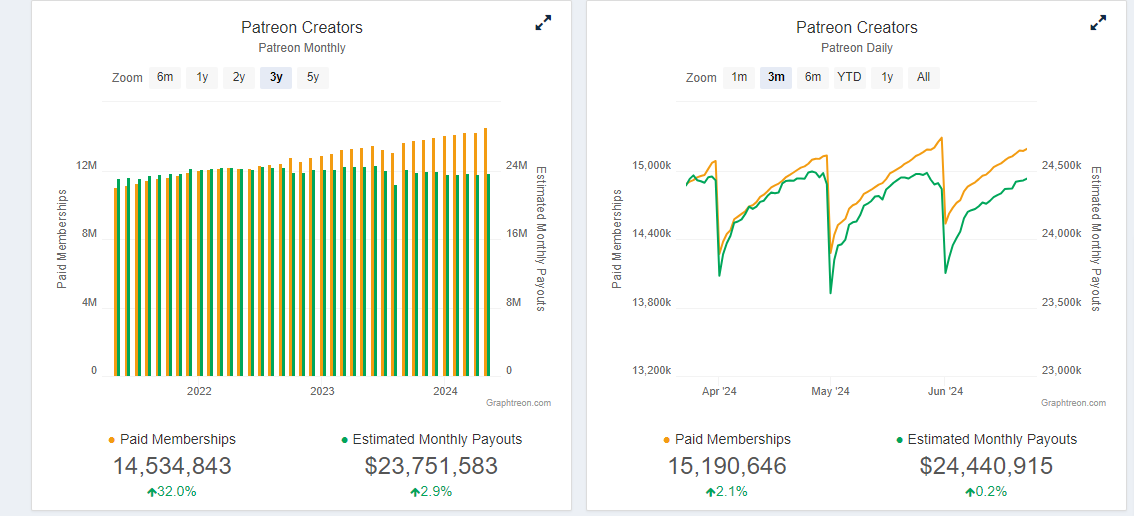
- The monthly creator earnings was around $23.6 million in January 2024. (Backlinko)
- In Patreon, videos and podcasts are the most popular niches with around $6 million earnings. (Influencer Marketing Hub)
- The platform generated around 12 million individual pledges every month in the previous year. (Influencer Marketing Hub)
- Patreon has a total funding of $413.3 million in eight rounds. (Influencer Marketing Hub)
How to Make an App like Patreon: A Complete Guide
Before diving into the workflow to make an app like Patreon, let’s quickly understand how the platform works!
Patreon hosts two major entities: creators and fans or patrons (as the platform terms them). Creators primarily make money from subscriptions, selling digital products, live events, etc. On the other hand, the fans get an excellent opportunity to connect with their favorite creators by availing their subscriptions.
Now, let’s understand how to make an app like Patreon with an 8-step process!
1. Choose a Profitable Niche
The first step in this how-to guide is to identify a lucrative niche for your Patreon clone. Do you wish to build a platform exclusively for music artists? Or an all-exclusive creator hub like Patreon?
As we know, Patreon is an all-inclusive platform for diverse creators, such as musicians, writers, comic artists, podcasters, etc.
Choose a niche for your Patreon-like app considering the following key factors:
- Expertise and skills
- Experience
- Passions or interests
- Relevant market trends
- Competitor analysis
- Niche profitability and demand
Here are a few trending niches to step into the creator economy:
- Musicians, pixel and art artists, professional photographers
- Cosplayers or crossplayers
- Freelance writers, authors, comic artists
- Podcasters
- Live game streamers
- Video Creators
- A unique niche like anime feminism (anifem is a mix of anime and feminism)
2. Business Analysis
Now that you have settled on a niche, it’s time you perform a bit of business analysis to ensure the feasibility of your app.
This typically helps to identify your business needs, increase development efficiency, define metrics for your business, etc.
Business analysis typically involves the following essential aspects:
- Discovery Stage
The first step in the discovery stage involves identifying your target audience, finding your USP. Here, a buyer’s persona is created based on the audience’s core characteristics such as demographics, psychographic details, behavioral patterns,etc. The data is collected through surveys, interviews & questionnaires.
- Market Scenario
This involves analyzing the emerging market trends, buying patterns, industry outlook, the expected industry growth, etc. This way, you can better understand where your product fits in the market.
- Competitor Analysis
List 4-5 competitors in your niche market. Perform a SWOT analysis identifying their unique position in the market. Ask questions like: What is the value proposition of each competitor? What is your competitor’s package pricing?
For instance, Ko-fi, Squarespace, and Fourthwall are a few of Patreon alternatives.
- Functional and Non-Functional Requirements
Do you consider livestreaming non-negotiable? Or does an exclusive merch seem to be an additional feature? Well, that’s what happens while examining functional and non-functional requirements.
While function requirements focus on the features, non-functional deals with the system’s operational capabilities.
3. Choose Your Monetization Model
You have determined your niche, devised a detailed business plan, it’s time to figure out your business model. In Michael Lewis’s book “The New, New Thing”, he defines a business model as how you plan to make money.
After all, a business or monetization model is the essence of your business — determining the long-term success of your product. It encompasses revenue streams, custom segments, and value proposition.
So, are you eager to build an app like Patreon? Here are some relevant business models worth-exploring:
-
Tiered- Subscription Model
A tiered membership model is where users decide the benefits to be offered for a specific pricing. The platform can either offer single-tiered or multi-tiered subscriptions. These benefits could be as digital ones or as physical things like merch.
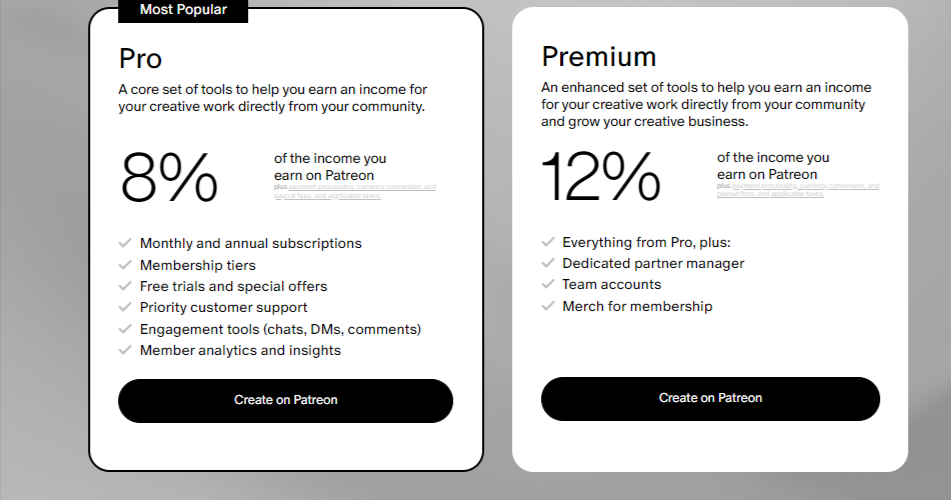
-
Freemium Model
Under this model, the platform offers the basic product features free of cost, while it charges for the premium ones. This way, platforms can acquire the initial set of clients offering the limited edition for a spin!
For example, you could offer a public feed and engagement features in the basic version and live streaming as a premium feature.
-
Sponsorship Model
Another lucrative model is the sponsorship model, where businesses pay the platform a considerable fee to promote their products. So, the platform earns a significant revenue, while the brand gets a stage for its promotions — a win-win!
-
Ad-Revenue Model
In this digital age, ads are an excellent means to monetize your platform. Hence, you can consider the ad-revenue model, where you sell your ad space to other businesses or organizations. Typically, the prices are decided based on the target audience, ad placement, and engagement levels.
4. Development
Next, let’s delve deeper into the Patreon clone app development process! That said, it’s the most important phase of the development process. It is divided into two parts: front-end and back-end development.
-
Front- End Development
This involves designing the interface for users to interact with the software. For instance, buttons, textbox, frames, sidebars, forms, etc. There are three approaches for front-end development: platform-specific, cross-platform, and hybrid. Design a user-friendly and easy-to-navigate platform for a great user experience!
Tech Stack:
React, HTML, CSS,Javascript
-
Back-end development
Here developers work on the back-end components: designing database architecture, servers and APIs, data-exchange between front-end to server. Simply, everything that you can’t see on the interface.
Tech Stack:
Python, Java, Node.js, MySQL, MongoDB
-
Integrations
The last step consists of connecting the front-end and back-end and integrating third-party apps for payments, live streaming, emails, etc.
5. Testing
Post-development comes the testing phase. Here the team performs desired quality checks to ensure the app meets the business and functional requirements.
Why is testing important? Fixing the bugs, defects and vulnerabilities in your app at an early stage is essential for a better user experience.Performance, functionality, design, compatibility across different screens are the common criterions for testing.
Real-world or beta testing is crucial to analyze how you can refine the app before the actual launch. End users are the entities who would ultimately use your app. Getting direct feedback would go a long way to building a resilient app.
6. Deployment and Maintenance
Deployment is a crucial phase that marks the transition from development to usability. The goal of app deployment is to make the app ready to be used on the target platform(iOS and Google Play Store).
It involves the following steps: packaging the app, configuring the servers, and installing the app. Basically, your app could be either native(specific to either iOS or Android) or cross-platform (run on both platforms).
The final stage of deployment is installing the app in the production environment and monitoring the app performance. Once the app is deployed your work is not over! You must ensure that the app remains relevant and secure for the users.
Maintenance phase addresses the following problems:
- Bug fixing
- Security updates
- Performance optimization
- Feature and compatibility updates
- Content updates
Overall, app maintenance is a continuous process!
7. Marketing
While your app is up there live and ready in the app store, prospective buyers still don’t know it exists! That’s why you need to advertise your app! This increases your visibility, drives lead-conversion, and also the app downloads.
Before choosing the right marketing channel, understand your target audience, figure out the platforms they often use!
For starters, here are a few marketing ideas to increase your app downloads:
- Employ App Store Optimization (ASO) for increasing app discoverability in search results. Optimize app name, description, relevant keywords, ratings, reducing acquisition costs.
- Establish yourself as an industry leader by curating blog posts, videos and hosting live events.
- Create the pre-launch “buzz” by releasing teasers, running contests and build up the hype
- Generate traffic through paid ads, social media and mobile advertising
- Leverage in-app marketing techniques, highlighting features, offering exciting deals to retain your existing clients
- Use social media to share interesting trends, insights, statistics and solutions.
What are the Must-Have Features of a Patreon-like App?
A Patreon-like app has three entities: creators, members, admin.
Key Features for Creators
- Build community by sharing images, videos, live streaming, polls etc
- Customizable membership tiers offering different benefits and rewards
- Engagement tools like private community, discord integration and creator lens
- An exclusive creator page showcasing all creator posts along with an option to “Join as Patreon”
- Creator Analytics with earnings reports, engagement metrics, patron management,etc
- Sell digital products including streamable audio and video, tutorials, guides, ebooks, templates, etc
- Merch membership to reward patrons and keep them engaged
- Flexible payments like automatic deposits to bank or Paypal accounts
- In-app wallet for convenient transactions
- Third-party app integrations with Zapier, WordPress, etc
Key Features for Members
- Get your hands on early access, exclusive and archived content.
- Customizable feed to track all content from the subscribed creators
- Explore creators from diverse categories like music, podcasts, video, writing, etc.
- Communication tools like community chats for creators and members, email notifications,etc.
- Manage memberships by upgrading or canceling them anytime
- Push notifications with latest updates on creator posts, releases, and exclusive content
- Support creators with a custom pledge starting at a minimum of $1
Key Features for Admin
- Track creator and member profiles
- Detailed analytics dashboard with bird’s eye view on platform revenue, commission earned,active creators and members,etc
- Manage pledges sent by members and their invoice details
- Earn commission based on the creator-specific subscription tiers
How Much Does it Cost to Make an App like Patreon?
The cost of creating a subscription-based platform like Patreon involves several aspects. Hence, it’s difficult to provide an exact estimation of the cost. However, a rough estimate comes to around $40,000 to $60,000.
Project complexity, development approach, developer rates,team size, tech stack are a few factors that influence the overall cost.
Here’s a detailed breakdown on the Patreon clone app development costs:
| Phases | Number of Hours | Cost |
| Planning & Research | 2- 4 weeks | $5,000 – $10,000 |
| UI/UX Design | 4 – 6 weeks | $7,000 – $12,000 |
| Development | 12 – 24 weeks | $15,000 – $30,000 |
| Testing and QA | 4 – 8 weeks | $5,000 – $6,000 |
| Deployment | 1- 2 weeks | $5,000 – $8,000 |
| Maintenance | 2- 4 weeks | $5,000 – $6,000 |
| Total Development Cost | 6 – 12 months | $42,000 – $72,000 |
Thus, it’s quite evident that building a Patreon-like app from scratch demands substantial time and cost. Besides, a complete ownership of the product from conceptualization to deployment is crucial to develop a viable product.
However, you can reduce the efforts and cost substantially with a ready made Patreon clone script like Fanso.io! Let’s explore this powerful solution!
Why Develop a Patreon Clone with Fanso.io?
Well, now you know that Patreon clone scripts are a profitable way to ease your hard-work, yet build your authority in the market!
So, what makes Fanso.io an ideal choice?
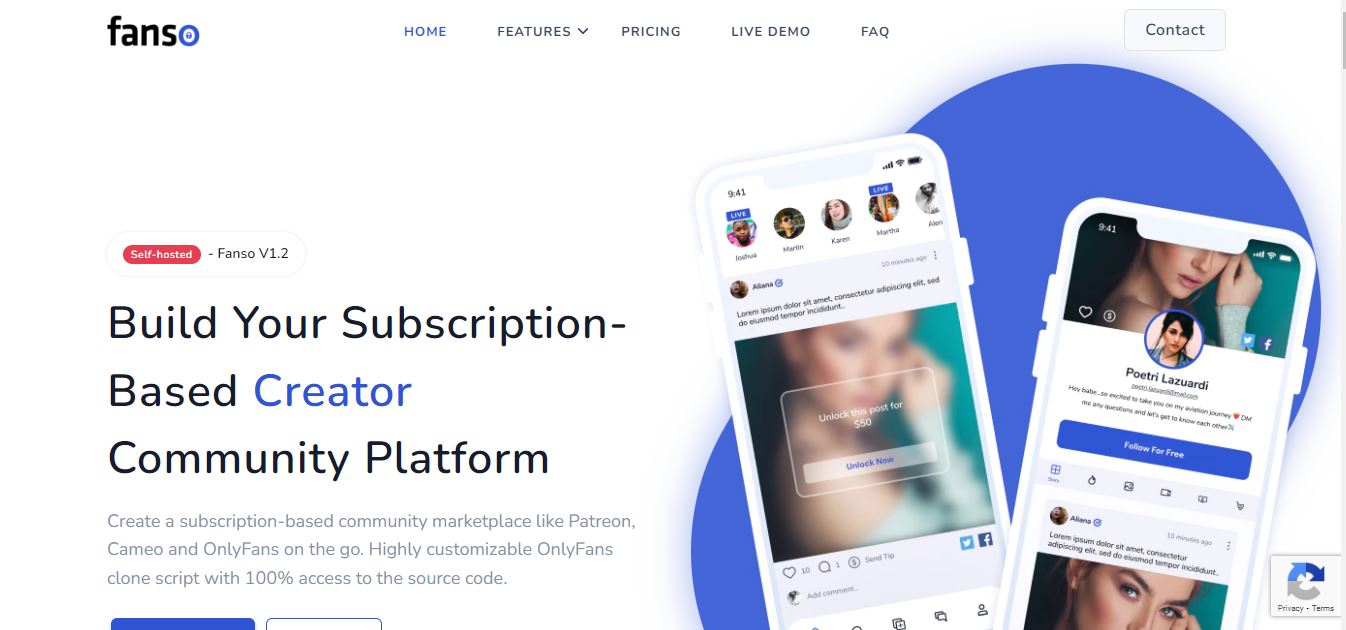
First off, it is a ready made Patreon clone script with all the key elements to build an app like Patreon. It is a self-hosted and white-label solution that gives enough room for customization and to grow as a brand.
Fanso is a robust solution to build a community marketplace like Patreon
On that note, let’s look at Fanso’s compelling feature that makes it a winning stake:
- Free and paid Subscriptions
Subscriptions are a great way to keep your fans engaged! With Fanso, creators can share exclusive posts,PPVs, polls, and live events with their subscribers.
- Diverse Monetization Channels
Creators can rake in profits from diverse revenue streams like subscriptions, PPVs, live streaming, tipping, paid DMs, and custom content.
- Social Community Features
It is power-packed with social community features like public feed, like/ bookmark posts, chat, profile suggestions, notifications, etc.
- Comprehensive Creator Dashboard
Extensive creator dashboard to manage media, payouts, and profile information.
- Detailed Analytics and Insights
Admin dashboard offers in-depth creator and user analytics, earnings and commission reports,etc.
- eCommerce Cart
Creators can sell physical or digital goods, track shipping, and offer exciting deals.
- Robust Tech Stack and Integrations
Fanso is built on the best-in-class tech stack and integrates with third-party apps like SendGrid, Agora, Google Analytics, and more.
Overall, Fanso has all it takes to put forth a dynamic platform experience, and trust us you won’t be disappointed!
Conclusion
Patreon is a trailblazing platform encouraging creative freedom and empowering the creator economy! Given the rapid-growth of this landscape, it’s a perfect moment to make an app like Patreon and turn creative pursuits into a steady income!
All you need is a robust and innovative solution to skip the groundwork! So, reach out to our experts to make your entrepreneurial journey less bumpy and effortless!
FAQ-Related to How to Make an App like Patreon
1. How much does it cost to build an app like Patreon?
It takes around $40,000 to $60,000 for Patreon clone app development. The pricing depends on several factors like project complexity, hourly development rates, location, and development method.
2. How to build an app like Patreon?
To build a Patreon clone app, first find a profitable niche, choose an appropriate business model, design and develop your app clone and lastly test and deploy it in the marketplace.
3. How profitable is Patreon?
Patreon works on a subscription-based model, where it takes away an 8% to 12% commission on every platform transaction. And its platform revenue is around $50-$75 million.

